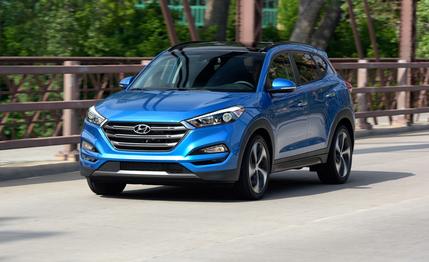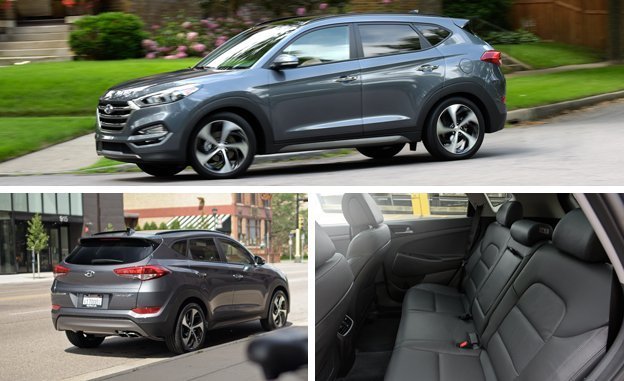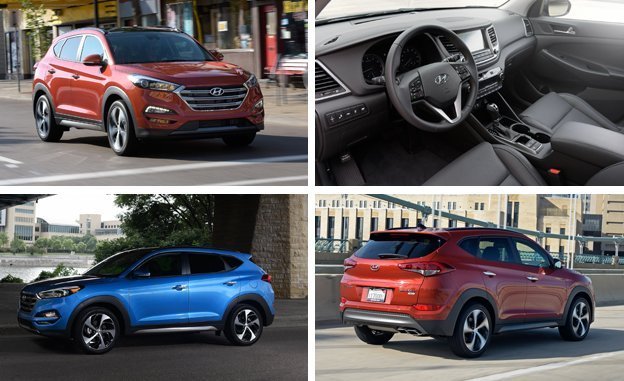 First Drive Review
First Drive Review
Forgive us for a second if we talk stick-and-ball sports, but the National Football League recently announced a new headline automotive sponsor, dumping General Motors for Hyundai. Indeed, despite the league’s ongoing domestic-violence woes, Hyundai is dropping $50 million of its marketing budget on the NFL, in large part because the carmaker’s sales have flattened over the last three years as Americans have resumed their own rocky love affair with trucks. And Korean trucks are as rare as NFL players who have never suffered a concussion.
What aren’t rare are Korean crossovers, which brings us to the redesigned 2016 Tucson. It’s definitely not a truck, but it’s close enough for Hyundai. And it’s close enough for most consumers, who last year made compact crossovers the single largest vehicle segment, ousting mid-size sedans from their position of dominance. The trend shows no signs of abating: The segment sales leader, the Honda CR-V, is on track to be its maker’s overall bestseller this year, ahead of both the Civic and the Accord by a substantial margin. So it’s a good time for Hyundai to be rolling out this new Tucson, which has been pumped up to slightly larger proportions to more closely match the CR-V.
Conservative play calling in Hyundai’s European design department has the new model looking similar to the old one from the curb. But the 2016 Tucson has been stretched by three inches overall and rides on a 1.2-inch-longer wheelbase. A 1.5-inch-longer front overhang makes the new one look a bit less stubby, and an additional 1.1 inches of width keeps the overall proportions balanced. Hyundai will happily tell you in exacting detail how much additional high-strength steel and structural adhesive was used and by how many percent these measures improved body rigidity. We’ll just say that this new Tucson feels far more substantial than the old one.
Hyundai’s improvements to the structure have allowed it to tune the suspension for a better ride quality than in the past. We came away from our drive impressed by the Tucson’s ability to handle both a rapid succession of highway expansion joints as well as larger bumps. You feel the Tucson’s high center of gravity in even the slightest cornering situation, but it remains well composed, without the excessive body motion that has been characteristic of Korean vehicles of the past. The steering is appropriately weighted, with a bit more initial heft provided by its electrical assist when the Tucson is placed in Sport mode. Manning the wheel is still an altogether dull experience, but it now meets the minimal-steering-feedback expectations for this class.

No, the Tucson is not a sporty vehicle—it certainly poses little threat to the Mazda CX-5’s hegemony—although there are some things about this new model that might lead you to believe otherwise. Hyundai has introduced a new Sport trim level, for one. But this is really just one rung in a ladder that now starts with the SE (last year’s base GLS having been dumped) before progressing through Eco, Sport, and, at the top of the pricing scale, Limited. In fact, the Sport and Eco trims differ mainly in their wheel sizes and equipment levels, with the latter achieving its superior fuel economy mainly by using the same 17-inch wheels as the SE. The Sport and Limited both ride on 19-inchers.
A base SE with front-drive can be had for as little as $23,595, while a four-wheel-drive Limited is $32,195. Or spend $34,945 to get the so-called Ultimate package on your Limited, which includes all the sorts of luxury and safety equipment that have come to define modern car shopping in every segment, including navigation, a panoramic sunroof, lane-departure warning, and automatic emergency braking. Hyundai says it expects the Limited to be the most popular version, with 40 percent of Tucson buyers taking one home, proving once again that Americans love to buy lots of extra stuff they don’t need.
A 164-hp, naturally aspirated 2.0-liter four-cylinder is available only on SE models, and this engine is the only way to get a conventional six-speed automatic in your Tucson. We skipped driving this one at the launch in favor of trying out the new-to-the-Tucson 1.6-liter turbocharged four making 175 horsepower and 195 lb-ft of torque. This is a 7-hp dip from last year’s top-of-the-line engine, but that 2.4-liter four made only 177 lb-ft of torque. The turbo engine is mated exclusively with a seven-speed dual-clutch automatic transmission, and it powers all Eco, Sport, and Limited versions.
Like virtually every other manufacturer, Hyundai has adopted the downsize-and-turbocharge engine strategy, which bumps EPA fuel-economy ratings without hamstringing performance. The Eco model returns as much as 29 mpg combined in EPA testing and all the 1.6-liter Tucsons have improved fuel economy compared with last year’s corresponding models with the larger four-cylinder.

The turbo Tucson is a pleasure to drive, with adequate power and a pleasant exhaust note. The transmission shifts as quickly and seamlessly as you'd expect, and it should certainly help the Tucson’s performance once we get one out to the test track. Yet compared to the standard-bearer for this sort of powertrain combination—Volkswagen’s 1.8-liter turbo matched with a six-speed DCT—Hyundai’s seems slower to rev and slower to shift, and certainly less targeted at the enthusiast.
Rather, Hyundai wants to play to the crossover crowd’s desire for maximum utility in a mundane-without-being-unstylish box. To this end, the new Tucson has a much larger cargo hold than last year’s model, the 31-cubic-foot total with the seats up being a full 5.3 bigger. That’s more than an extra Mazda Miata trunk’s worth of space, and it remedies the largest knock against the previous Tucson, which had a roomy rear seat and otherwise good packaging. The rest of the Tucson’s insides are perhaps not as exciting as its trunk, with the Californian design team responsible for the new interior delivering as inoffensive a look as did the Europeans who penned the sheetmetal. But if the Tucson’s innocuous swaths of hard plastic are not as pleasing to touch as those in some of its competitors, they at least seem to be screwed together well.
It’s the screwing-together part that’s actually the single most newsworthy point about the new Tucson, in that Hyundai has expanded manufacturing capacity to fulfill its grandiose plans to sell 90,000 of these trucklets in the U.S. next year. In the past, the Korea-assembled Tucson was shipped across the globe, including to both Europe and the United States. But Europe now has its own dedicated factory, so Hyundai’s Tucson-starved American dealers will have access to a supply that’s almost double the 47,000 they sold in 2014. We can already imagine the NFL-themed ads to come. Hyundai Night Football, anyone?